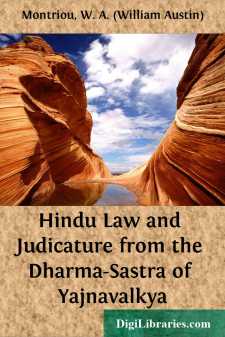Categories
- Antiques & Collectibles 13
- Architecture 36
- Art 48
- Bibles 22
- Biography & Autobiography 813
- Body, Mind & Spirit 142
- Business & Economics 28
- Children's Books 13
- Children's Fiction 10
- Computers 4
- Cooking 94
- Crafts & Hobbies 4
- Drama 346
- Education 46
- Family & Relationships 57
- Fiction 11828
- Games 19
- Gardening 17
- Health & Fitness 34
- History 1377
- House & Home 1
- Humor 147
- Juvenile Fiction 1873
- Juvenile Nonfiction 202
- Language Arts & Disciplines 88
- Law 16
- Literary Collections 686
- Literary Criticism 179
- Mathematics 13
- Medical 41
- Music 40
- Nature 179
- Non-Classifiable 1768
- Performing Arts 7
- Periodicals 1453
- Philosophy 64
- Photography 2
- Poetry 896
- Political Science 203
- Psychology 42
- Reference 154
- Religion 513
- Science 126
- Self-Help 84
- Social Science 81
- Sports & Recreation 34
- Study Aids 3
- Technology & Engineering 59
- Transportation 23
- Travel 463
- True Crime 29
Hindu Law and Judicature from the Dharma-Sastra of Yajnavalkya
Categories:
Description:
Excerpt
Of the above list, twenty (distinguished by one cross) are in Yájnavalkya's list: seventeen of these are named by Paráà âºara, viz. all except Yama, Brihaspati and Vyása, instead of whom he gives Kaà âºyapa, Gárgya and Prachetas: the Padma Puráá¹â¡a gives those named by Yájnavalkya, with the exception of Atri, and seventeen others, (distinguished by two crosses) three of whom, Prachetas, Kaà âºyapa and Gárgya, are on Paráà âºara's list, and the remaining fourteen, not before mentioned: Madhusúdana Saraswatà names the same nineteen of Yájnavalkya's list, also Devala, Nárada, Paiá¹hÃnasi: Ráma Krishá¹â¡a, in his gloss to the Grihya Sútras of Páraskara, mentions thirty-nine, of whom nine (distinguished by three crosses) are new ones. There is also a Dharma à šástra attributed to à šankha and Likhita jointly, thus making forty-seven in the whole. The professor considers all to be extant; and has himself met with quotations from all, except Agni, Kuthumi, Budha, à šáá¹yáyana, and Soma.
To those may be added several recensions of the same Dharma à šástras, of which professor Stenzler speaks to having read of twenty-two.
The entire forty-seven are independent sources of and authorities upon Hindu law.
The Digest of Jagannát'ha Tarcapanchánana, as translated by Colebrooke, is a valuable repertory of texts; but, detached and isolated as they necessarily are, those texts can with difficulty be appreciated or applied.
Yájnavalkya is second in importance to Manu alone: and, with the commentary, is the leading authority of the Mithilá school.
The resident of British India needs not to be informed, that the orthodox Hindu regards his Dharma à šástras as direct revelations of the Divine will: still less need such an one be told, that, among this people, law is entirely subservient to the mysterious despotism of cast, a religious, rather than a political ordinance.
With the Hindu, all religious tenets and aspirations are centred in the idea of BRAHMA, the one, pervading, illimitable substance, without multiple, division or repetition. This idea has two modes or phases, 1st. as representing the absolute, self-included Brahmá; 2nd. as representing Brahmá in connection with, relative to, the world. In the latter, Brahmá is creator of the world, or, the very world, a semblance or a development of the former, the absolute idea. Man's highest aspiration and aim is, to know Brahmá absolutely: to have attained this knowledge implies a total renunciation of worldly concerns, to coalesce with, to be ultimately absorbed in, reunited with, Brahmá. Bráhmaá¹â¡as are held to possess, to represent, this knowledge. Again, Brahmá is the creator, the preserver, also, the objects created and preserved. Kshattriyas represent Brahmá, the preserver: Vaisyás, Brahmá the preserved. The dogma is otherwise explained: in the secondary or relative notion, Brahmá is Sattwa, Rajas, Tamas, i. e. goodness, activity, darkness,—respectively represented by the Bráhmaá¹â¡a, Kshattriya, and Vaisyá casts.
When the Hindus dwelt in the country of the five rivers, and were worshippers of the powers and phenomena of material Nature, as of Indra, Váyu, Agni &c., cast was necessarily unknown, for the notion of Brahmá was undeveloped.
The divisions or classes among them were conventional; there were princes, priests, and peasants or cultivators.
But class distinction had not then crystallized into cast, into immiscible, uncongenial yet co-ordinate elements of a so called revealed constitution.
So soon however as the idea of Brahmá had attained fixity in the Hindu mind, and simultaneously with it, cast was developed, as we find it (but imperfectly) in the earliest records of Hindu philosophy, the Upanishads.
Thus, cast governs and is antecedent to law, which must bend and adapt itself to cast, as the overruling, intrinsic, unalterable condition of Hinduism, of Hindu life. There is one law, one phase of obligation for the twice-born, another for the à šúdrá. In Manu, cast is not so fully and severely developed: Manu permits to the Bráhmaá¹â¡a four wives, of whom one may be a à šúdrá, necessarily permitting, therefore, a transition or quasi-amalgamation between the highest and the lowest in the scale....


